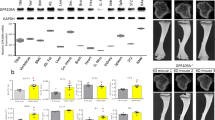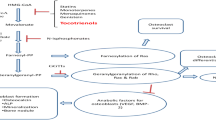Abstract
GPR40 is a free fatty acid receptor that has been recently shown to impact bone remodeling. This receptor protects skeleton by inhibiting bone resorbing osteoclast differentiation. Consistent with GPR40 expression on bone forming cells, we assumed that this receptor may also influence osteoblast activity. To further investigate this hypothesis, biological effects of GW9508, a synthetic agonist for GPR40, was first tested on osteoblast differentiation parameters. Assays were performed in two different cell models: the MC3T3-E1 osteoblastic cell line and primary bone marrow cultures extracted from wild-type and GPR40 knock-out mice. Both models showed a dual role of GPR40 on osteoblasts. Although receptor stimulation induced early stimulation of differentiation marker expression, it finally led to inhibition of mineralization process during late differentiation stages. To further elucidate this discrepancy, mice were ovariectomized to induce bone loss and received GPR40 agonist by gavage. Data revealed a weak influence of GPR40 agonist on osteoblast markers expression. Nevertheless, a significant increase in OPG expression was observed upon GW9508 treatment that contribute to explain the GPR40-related osteoporosis prevention. To conclude, our results confirm the relevance of this new opportunity in the management of bone loss.






Similar content being viewed by others
Abbreviations
- ALP:
-
Alkaline phosphatase
- GPR40:
-
G-protein receptor 40
- KO:
-
Knock-out
- NF-κB:
-
Nuclear factor kappa B
- OPG:
-
Osteoprotegerin
- OVX:
-
Ovariectomized
- RANKL:
-
Receptor activator of NF-κB ligand
- Runx2:
-
Runt related transcription factor 2
- SH:
-
Sham-operated
- TLDA:
-
Taqman low-density arrays
- TZD:
-
Thiazolidinediones
- WT:
-
Wild-type
References
Corwin RL (2003) Effects of dietary fats on bone health in advanced age. Prostaglandins Leukot Essent Fatty Acids 68:379–386
Calder PC (2006) n-3 polyunsaturated fatty acids, inflammation, and inflammatory diseases. Am J Clin Nutr 83:1505S–1519S
Ono K, Kaneko H, Choudhary S, Pilbeam CC, Lorenzo JA et al (2005) Biphasic effect of prostaglandin E2 on osteoclast formation in spleen cell cultures: role of the EP2 receptor. J Bone Miner Res 20:23–29
Tsutsumi R, Xie C, Wei X, Zhang M, Zhang X et al (2009) PGE2 signaling through the EP4 receptor on fibroblasts upregulates RANKL and stimulates osteolysis. J Bone Miner Res 24:1753–1762
Briscoe CP, Tadayyon M, Andrews JL, Benson WG, Chambers JK et al (2003) The orphan G protein-coupled receptor GPR40 is activated by medium and long chain fatty acids. J Biol Chem 278:11303–11311
Brown AJ, Goldsworthy SM, Barnes AA, Eilert MM, Tcheang L et al (2003) The Orphan G protein-coupled receptors GPR41 and GPR43 are activated by propionate and other short chain carboxylic acids. J Biol Chem 278:11312–11319
Diascro DD Jr, Vogel RL, Johnson TE, Witherup KM, Pitzenberger SM et al (1998) High fatty acid content in rabbit serum is responsible for the differentiation of osteoblasts into adipocyte-like cells. J Bone Miner Res 13:96–106
Himes RW, Smith CW (2010) Tlr2 is critical for diet-induced metabolic syndrome in a murine model. Faseb J 24:731–739
Hwang D (2001) Modulation of the expression of cyclooxygenase-2 by fatty acids mediated through toll-like receptor 4-derived signaling pathways. Faseb J 15:2556–2564
Maurin AC, Chavassieux PM, Meunier PJ (2005) Expression of PPARgamma and beta/delta in human primary osteoblastic cells: influence of polyunsaturated fatty acids. Calcif Tissue Int 76:385–392
Covington DK, Briscoe CA, Brown AJ, Jayawickreme CK (2006) The G-protein-coupled receptor 40 family (GPR40-GPR43) and its role in nutrient sensing. Biochem Soc Trans 34:770–773
Itoh Y, Kawamata Y, Harada M, Kobayashi M, Fujii R et al (2003) Free fatty acids regulate insulin secretion from pancreatic beta cells through GPR40. Nature 422:173–176
Latour MG, Alquier T, Oseid E, Tremblay C, Jetton TL et al (2007) GPR40 is necessary but not sufficient for fatty acid stimulation of insulin secretion in vivo. Diabetes 56:1087–1094
Wauquier F, Philippe C, Leotoing L, Mercier S, Davicco MJ et al (2013) The free fatty acid receptor G protein-coupled receptor 40 (GPR40) protects from bone loss through inhibition of osteoclast differentiation. J Biol Chem 288:6542–6551
Mieczkowska A, Basle MF, Chappard D, Mabilleau G (2012) Thiazolidinediones induce osteocyte apoptosis by a G protein-coupled receptor 40-dependent mechanism. J Biol Chem 287:23517–23526
Cornish J, MacGibbon A, Lin JM, Watson M, Callon KE et al (2008) Modulation of osteoclastogenesis by fatty acids. Endocrinology 149:5688–5695
Briscoe CP, Peat AJ, McKeown SC, Corbett DF, Goetz AS et al (2006) Pharmacological regulation of insulin secretion in MIN6 cells through the fatty acid receptor GPR40: identification of agonist and antagonist small molecules. Br J Pharmacol 148:619–628
Wang W, Li F, Wang K, Cheng B, Guo X (2012) PAPSS2 promotes alkaline phosphates activity and mineralization of osteoblastic MC3T3-E1 cells by crosstalk and Smads signal pathways. PLoS ONE 7:e43475
Doi Y, Horiguchi T, Kim SH, Moriwaki Y, Wakamatsu N et al (1992) Effects of non-collagenous proteins on the formation of apatite in calcium beta-glycerophosphate solutions. Arch Oral Biol 37:15–21
Hosseini S, Naderi-Manesh H, Mountassif D, Cerruti M, Vali H et al (2013) C-terminal amidation of an osteocalcin-derived peptide promotes hydroxyapatite crystallization. J Biol Chem 288:7885–7893
Romberg RW, Werness PG, Riggs BL, Mann KG (1986) Inhibition of hydroxyapatite crystal growth by bone-specific and other calcium-binding proteins. Biochemistry 25:1176–1180
Dupin E, Calloni GW, Le Douarin NM (2010) The cephalic neural crest of amniote vertebrates is composed of a large majority of precursors endowed with neural, melanocytic, chondrogenic and osteogenic potentialities. Cell Cycle 9:238–249
Kaplamadzhiev DB, Hisha H, Adachi Y, Ikehara S, Tonchev AB et al (2010) Bone marrow-derived stromal cells can express neuronal markers by DHA/GPR40 signaling. Biosci Trends 4:119–129
Ma D, Zhang M, Larsen CP, Xu F, Hua W et al (2010) DHA promotes the neuronal differentiation of rat neural stem cells transfected with GPR40 gene. Brain Res 1330:1–8
Chipoy C, Berreur M, Couillaud S, Pradal G, Vallette F et al (2004) Downregulation of osteoblast markers and induction of the glial fibrillary acidic protein by oncostatin M in osteosarcoma cells require PKCdelta and STAT3. J Bone Miner Res 19:1850–1861
Wittrant Y, Theoleyre S, Chipoy C, Padrines M, Blanchard F et al (2004) RANKL/RANK/OPG: new therapeutic targets in bone tumours and associated osteolysis. Biochim Biophys Acta 1704:49–57
Doshi LS, Brahma MK, Sayyed SG, Dixit AV, Chandak PG et al (2009) Acute administration of GPR40 receptor agonist potentiates glucose-stimulated insulin secretion in vivo in the rat. Metabolism 58:333–343
Kebede M, Alquier T, Latour MG, Semache M, Tremblay C et al (2008) The fatty acid receptor GPR40 plays a role in insulin secretion in vivo after high-fat feeding. Diabetes 57:2432–2437
Fulzele K, Clemens TL (2012) Novel functions for insulin in bone. Bone 50:452–456
Ito R, Tsujihata Y, Matsuda-Nagasumi K, Mori I, Negoro N et al (2013) TAK-875, a GPR40/FFAR1 agonist, in combination with metformin prevents progression of diabetes and beta-cell dysfunction in Zucker diabetic fatty rats. Br J Pharmacol 170(3):568–580
Gowda N, Dandu A, Singh J, Biswas S, Raghav V et al (2013) Treatment with CNX-011-67, a novel GPR40 agonist, delays onset and progression of diabetes and improves beta cell preservation and function in male ZDF rats. BMC Pharmacol Toxicol 14:28
Christiansen E, Hansen SV, Urban C, Hudson BD, Wargent ET et al (2013) discovery of TUG-770: a highly potent free fatty acid receptor 1 (FFA1/GPR40) agonist for treatment of type 2 diabetes. ACS Med Chem Lett 4:441–445
Araki T, Hirayama M, Hiroi S, Kaku K (2012) GPR40-induced insulin secretion by the novel agonist TAK-875: first clinical findings in patients with type 2 diabetes. Diabetes Obes Metab 14:271–278
de Almeida Pereira Coutinho M, Bandeira E, de Almeida JM, Godoi ET, Vasconcelos G et al (2013) Low bone mass is associated with increased carotid intima media thickness in men with type 2 diabetes mellitus. Clin Med Insights Endocrinol Diabetes 6:1–6
Leslie WD, Rubin MR, Schwartz AV, Kanis JA (2012) Type 2 diabetes and bone. J Bone Miner Res 27:2231–2237
Acknowledgments
GPR40−/− mice were obtained from Vincent Poitout, Thierry Alquier and Amgen Inc. Thousand Oaks, CA, USA. We also thank Emilie Daudet for her technical assistance.
Author information
Authors and Affiliations
Corresponding author
Ethics declarations
Conflict of interest
All the authors state that they have no conflicts of interest.
Rights and permissions
About this article
Cite this article
Philippe, C., Wauquier, F., Lyan, B. et al. GPR40, a free fatty acid receptor, differentially impacts osteoblast behavior depending on differentiation stage and environment. Mol Cell Biochem 412, 197–208 (2016). https://doi.org/10.1007/s11010-015-2626-5
Received:
Accepted:
Published:
Issue Date:
DOI: https://doi.org/10.1007/s11010-015-2626-5




